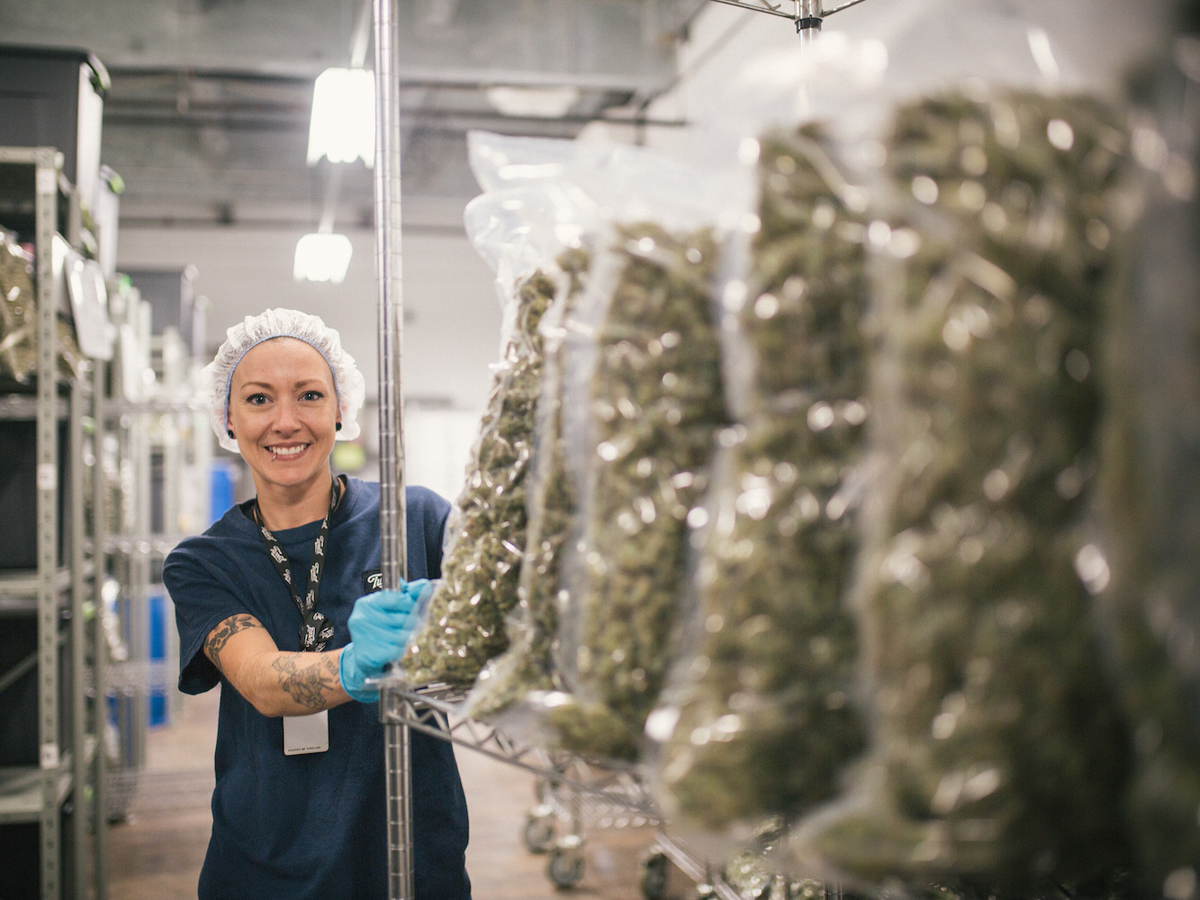The ‘world’s biggest legal pot dealer’ talks about the future of cannabis

Pic: Godji10 / iStock / Getty Images Plus via Getty Images
Bruce Linton says he’s the “world’s biggest legal-weed dealer”.
Drop one very important word – “legal” – from the chief executive’s title and that meaning changes drastically.
A longtime technology entrepreneur, Linton made his first foray into the marijuana industry as part of a process known as “chain of custody” – to ensure nothing tainted a crop either before, during, or after it’s grown.
After founding Canopy Growth five years ago in Smiths Falls, Canada – a small town in eastern Ontario, Canada – Linton has overseen the company’s growth to 6 million square feet of production space, which helped it bring in $US78 million of revenue last year.
In May it became the first marijuana company to trade on the New York Stock Exchange and now has a market value of $US5.7 billion.
Here Linton speaks about how how marijuana companies are disrupting traditional pharmaceuticals, and what’s next for the world’s largest publicly traded marijuana company.
What are the biggest misconceptions people have about the legal-marijuana industry?
Bruce Linton: If I had told you five years ago what I was going to create and how we’re going to do it, you would have thought for sure this person is insane or criminal. At that time there were only four countries at a federal level even trying to figure out how to manage this. Now there are 29. So the probability that you will have encountered some information about this topic – not just in the US, but if you’re in France, Germany, or England – is quite high.
Five years ago finding any investor was a challenge. Now we have just completed a $US600 million convertible [debt round], all institutionally placed with about 90% in Europe and the US – and I mean the big names.
If I were to talk to your aunt or uncle or parent about what I did three years ago, they would have been very glad you didn’t work for me. Now they’re asking, “Why don’t you work at the company? That’s the future.” That’s because it takes a little time to work through the layers. Currently, someone might say, “Well, I use a pharmaceutical product that’s been given to me by my doctor, so it must be safe.”
>> Which ASX cannabis stocks hold those golden Aussie cannabis licences
Now the US opioid crisis has actually triggered people to question all pharmaceutical products – and I don’t think that gets enough perspective. What had been a daily routine for many people turned out to be way worse than ever contemplated. People are starting to say, “Is there anything else like that that I’m being prescribed? What else is out there? How should I look at it?”
Now the opioid crisis has actually triggered people to question all pharmaceutical products.
The people who you thought would be least likely to be supportive – your parents, or mine – in fact are patients of other pharmaceutical products and therefore are actually becoming way more sceptical of those and looking for better solutions. That has meant we get a lot more of those people who want to become investors.
Young investors have been snapping up the stock like crazy.What do you hear from them and how do you pitch the investment to them?
Linton: When I deal with the younger cohort, say 25-year-olds, the surprising part to me is they may say, “Is this just a flash or is this a real thing here?” So I have to really take them on a journey to show them how disruptive it is to pharma and alcohol, and why it isn’t currently medical marijuana even though it’s called that.
Until it goes through all the necessary protocol and programs, it’s just marijuana. You can call yourself a doctor, but until you go to school and achieve it, you’re not. A lot of people who have had a routine exposure to marijuana don’t see it as a potential medical disrupter that it is until you kind of push their buttons.
Eventually people start wondering, “Christ, I want to have a hand in that.” Since you can’t possibly short anybody who’s in the opioid business, because there’s no short left on anything like that, so they start to say, “Maybe I’ll buy the future.”
What about the alcohol industry? Constellation Brands – which owns Corona – has a roughly 10% stake in your company.
Linton: We’ve seen a lot of those guys before we decided who we wanted to work with. Part of the reason we like them isn’t just because they’re a diversified beverage maker – meaning they do beer, wine, and spirits – but because they’re actually entrepreneurial.
They’re a Fortune 500 company that runs hard because they’re run by the founding family. Because we’re a startup that’s driving hard, do you think I could have a partnership with some place that was run by committee? No chance.
Because we’re a startup that’s driving hard, do you think I could have a partnership with some place that was run by committee? No chance.
They were the first to publicly state they should be in the cannabis game. What they were really saying is, “We believe people should have a choice in how they wish to improve or alter their socialisation.”
What about tobacco companies? Will marijuana disrupt them as well?
Linton: Maybe. We’re not really a substitute for nicotine. If you’re hooked on nicotine, you’re hooked on nicotine.
What is your production facility like? Is there anything about it that might surprise someone not familiar with the industry?
Linton: Our total operational platform right now is about 6 million square feet. When you go to 100,000 square feet, that sounds big, but it’s not until 1 million square feet where you start to tickle the whole process of, “How do I make this a continuous flow versus batches?” When you get to these numbers, everything has to be a continuous operation. That’s what we’re learning now.
When you get to these numbers, everything has to be a continuous operation. That’s what we’re learning now.
There are all kinds of procedures to be sure what you’re getting is what it’s stated to be. We have to be sure it doesn’t have everything from molds and mildews to faecal chloroforms on it, and hasn’t been treated with chemicals. It has to be what you thought it was, and, if you like it, you can get the same thing every time.
They didn’t view themselves so much as a beverage company so much as an entity that provides occasions with some kind of lift, if you will. So that’s an easy way to look at cannabis, not as a threat, but as an alternative or additional. I think that’s caused every other beer, wine, and spirits provider to have a headache. Can you imagine being the CEO of any one of those other entities now that this has happened?
What other products are you selling or looking into in addition to smokable marijuana?
Linton: Once it becomes completely legal and socially acceptable, there will basically be one of two legal choices between alcohol and cannabis. I think over time the format of the product is going to get more and more similar. We will definitely be making beverages, but since there is no alcohol there will be no calories, which means the pounding on your liver is effectively nil. And did I mention the no-calories part? The idea that you get access to the biggest wallets with a virtue of no calories yet feeling a bit upbeat and positive is a pretty compelling argument.
In Canada there are rules for everything; that’s just part of being Canadian. Right now, it’s a medical-only market that allows us to sell dried cannabis. Oils extracted from cannabis are also acceptable, but they need to be bulked up again with another oil-like sunflower oil, and are designed so that they could be used as a cooking agent or gel cap. We can’t make any sort of vape pen, drinkable, or chewable products as finished goods right now.
When recreational marijuana begins they have added a specific thing that says you can have measured quantities, which means you could roll it in a joint, but it can’t be edible. By mid-2019, we’re going to be able to layer on more things that are similar to what you might see in the US market.
When you’re doing stuff at this scale you start to think about things like beverages, vape pens, and chewable very differently. There’s a whole range of things you’ll start to see in our product offering in 2019, and that should increase margins because you’re not really selling just cannabis – you’re taking it and putting it into something else, which usually means much better margins.
Marijuana is legal in some US states – like Colorado – why don’t you have a presence in the US?
Linton: We do not participate in the US because that would mean I have broken a federal law, and we don’t do that, which is why we can be on the New York Stock Exchange because we’re fully compliant in our operations and all geographies.
I’m offered phenomenal opportunities in the US, but then I would be outside, and almost all the other cannabis companies do participate in those markets, but we’ll go there when we have done everything we can globally on scale and it becomes federally legal.
Do you think we’ll see fully legal marijuana in the US anytime soon?
Linton: I have a very weak predictive model and whether or not it will rain tomorrow, let alone what is going to happen on geopolitical issues related to cannabinoids. Anyone who tells you they have an answer, you should actually see if you can get them some form of examination. Make sure they see a shrink real soon.
You said Germany was about 10% of your business. What other areas are your focus going forward?
Linton: Our big boost for the next 12 months is Canada, with the second [recreational] market coming on. We’ve got medical cranking. Germany’s ramping up on medical. Greece yesterday released new regulations. Denmark has theirs out. Australia, Brazil, Chile, Colombia. This thing is going on around the world at an unbelievable pace, and often these places look an awful lot like the methods that Canada’s figured out over the last 17 years. We started this with the intention of participating globally wherever the rules permitted us on a fully legal basis.
UNLOCK INSIGHTS
Discover the untold stories of emerging ASX stocks.
Daily news and expert analysis, it's free to subscribe.
By proceeding, you confirm you understand that we handle personal information in accordance with our Privacy Policy.











